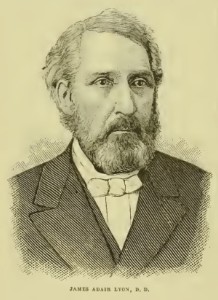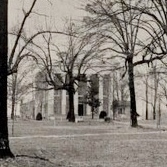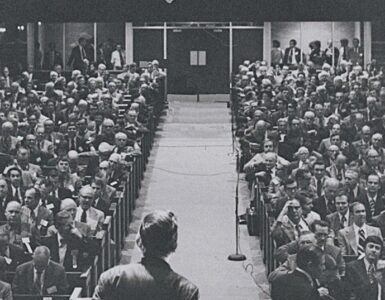 James Adair was born to Ezekiel L. and Mary Adair Lyon near Jonesborough, Tennessee on April 19, 1814. His early education was obtained at home and in a local academy. The Lyons attended the Presbyterian Church in Jonesborough and James professed faith in Christ at the age of seven. To prepare formally for the ministry, he went to Washington College in his Tennessee homeland graduating in 1832, but then for theological instruction he went north to Princeton Seminary in New Jersey completing his program in four years. He was licensed by the Presbytery of New Brunswick in 1836. The year 1837 was an eventful one for Licentiate Lyon because after he married Adelaide E. Deadrick of Knoxville, Tennessee, March 14, two months later the Presbyterian Church divided into two denominations, the Old and New Schools, when the presbyters constituting the Old School ejected those constituting the New School. Lyon was ordained an evangelist by the Old School Presbytery of Holston in September to serve the churches in Rogersville and New Providence, Tennessee.
James Adair was born to Ezekiel L. and Mary Adair Lyon near Jonesborough, Tennessee on April 19, 1814. His early education was obtained at home and in a local academy. The Lyons attended the Presbyterian Church in Jonesborough and James professed faith in Christ at the age of seven. To prepare formally for the ministry, he went to Washington College in his Tennessee homeland graduating in 1832, but then for theological instruction he went north to Princeton Seminary in New Jersey completing his program in four years. He was licensed by the Presbytery of New Brunswick in 1836. The year 1837 was an eventful one for Licentiate Lyon because after he married Adelaide E. Deadrick of Knoxville, Tennessee, March 14, two months later the Presbyterian Church divided into two denominations, the Old and New Schools, when the presbyters constituting the Old School ejected those constituting the New School. Lyon was ordained an evangelist by the Old School Presbytery of Holston in September to serve the churches in Rogersville and New Providence, Tennessee.
Rev. Lyon’s next call required him to leave his home state, move southwest across the Tennessee River and the state of Alabama into Mississippi for ministry with the Presbyterian Church in Columbus. Rev. Lyon served the congregation as stated supply from October 1841 to May 1847. Sometimes lengthy tenures in supply positions occur because congregations want ample time to consider a minister’s gifts, but in other cases churches simply cannot afford to pay full-time salaries. When Lyon started in Columbus there were about forty members and by the time he left in 1847, the congregation included eighty-five communicants. The reason for his leaving may have been health related because he traveled overseas for about a year. Physicians of the day sometimes prescribed extended travel for patients, as was the case of Henry A. Boardman, so Lyon’s travels may have been therapeutic. When he returned to the States he accepted a call to the Westminster Presbyterian Church in St. Louis, Missouri, and was installed November 15, 1848. After a brief tenure of two years, he left the church and established a high school for young ladies in St. Louis. In 1854, Washington College honored him with the Doctor of Divinity during its graduation festivities, then in October he returned to his former church in Columbus, Mississippi, to be duly installed the pastor January 7, 1855. He continued his ministry at Columbus for sixteen years, which when added to his previous term as stated supply gives a total of twenty-two years of service.
 In 1859, Charles Darwin’s Origin of the Species was published, which resulted in responses from all quarters but especially from Christians. A member of Lyon’s church, Hon. John Perkins, Sr., endowed a professorship of natural science in connection with revealed religion at Columbia Theological Seminary in South Carolina in 1860. Pastor Lyon was an important figure for working out the details of the new professorship. During a visit to Columbia, Lyon stayed with James H. Thornwell and enjoyed a carriage ride with him as they toured the city. Lyon also preached in the First Presbyterian Church, then the next day attended the wedding of John B. Adger’s eldest daughter to Rev. Francis Mullally who shared pastoral duties with Thornwell. Once the details of the new professorship were organized, James Woodrow was selected the first Perkins professor and began teaching in 1861. Woodrow’s views on creation and evolution would become the subject of extended controversy in the 1880s in Columbia Seminary and the Presbyterian Church in the United States (PCUS).
In 1859, Charles Darwin’s Origin of the Species was published, which resulted in responses from all quarters but especially from Christians. A member of Lyon’s church, Hon. John Perkins, Sr., endowed a professorship of natural science in connection with revealed religion at Columbia Theological Seminary in South Carolina in 1860. Pastor Lyon was an important figure for working out the details of the new professorship. During a visit to Columbia, Lyon stayed with James H. Thornwell and enjoyed a carriage ride with him as they toured the city. Lyon also preached in the First Presbyterian Church, then the next day attended the wedding of John B. Adger’s eldest daughter to Rev. Francis Mullally who shared pastoral duties with Thornwell. Once the details of the new professorship were organized, James Woodrow was selected the first Perkins professor and began teaching in 1861. Woodrow’s views on creation and evolution would become the subject of extended controversy in the 1880s in Columbia Seminary and the Presbyterian Church in the United States (PCUS).
 Lyon continued his ministry through the difficult years of the Civil War and into Reconstruction. In 1863, he was moderator of the General Assembly meeting of the Presbyterian Church in the Confederate States of America (PCCSA, became PCUS after the war). He delivered his retiring moderator’s sermon the next year from I Thessalonians 2:4. In August 1870, Dr. Lyon was elected professor of mental and moral science in the University of Mississippi at Oxford, where he worked until he retired in June 1881 due to declining health. During his life he had been offered several calls to churches and teaching positions, including Danville Seminary, but after his time in St. Louis, he continued his work exclusively in Mississippi. James A. Lyon, D.D., died on May 15, 1882, in Holly Springs, Mississippi, in the home of his son-in-law, Eagleton M. Smith, Esq., following four or five days of paralysis. He was survived by his wife, Adelaide, and six children. Lyon contributed several articles to the Southern Presbyterian Review, and his sermons and comments were published in Columbus newspapers and other periodicals including True Witness and Sentinel (Memphis and New Orleans).
Lyon continued his ministry through the difficult years of the Civil War and into Reconstruction. In 1863, he was moderator of the General Assembly meeting of the Presbyterian Church in the Confederate States of America (PCCSA, became PCUS after the war). He delivered his retiring moderator’s sermon the next year from I Thessalonians 2:4. In August 1870, Dr. Lyon was elected professor of mental and moral science in the University of Mississippi at Oxford, where he worked until he retired in June 1881 due to declining health. During his life he had been offered several calls to churches and teaching positions, including Danville Seminary, but after his time in St. Louis, he continued his work exclusively in Mississippi. James A. Lyon, D.D., died on May 15, 1882, in Holly Springs, Mississippi, in the home of his son-in-law, Eagleton M. Smith, Esq., following four or five days of paralysis. He was survived by his wife, Adelaide, and six children. Lyon contributed several articles to the Southern Presbyterian Review, and his sermons and comments were published in Columbus newspapers and other periodicals including True Witness and Sentinel (Memphis and New Orleans).
Barry Waugh
Sources–The header shows norther Mississippi as in Appleton’s Atlas, 1878; nicely done atlas. The square black-and-white picture shows the University of Mississippi in the nineteenth century. Regarding James Woodrow and the evolution controversy, see the Woodrow biography by A. H. Freundt in Dictionary of the Presbyterian and Reformed Tradition in America, editors, Hart and Noll, 1999. See D. Calhoun’s, The Glory of the Lord Risen Upon it, pages 88, 101, regarding Mullally and First Church. Other sources included Scott’s Ministerial Directory, Princeton Seminary’s Necrological Report, and other reference dictionaries and encyclopedias.





